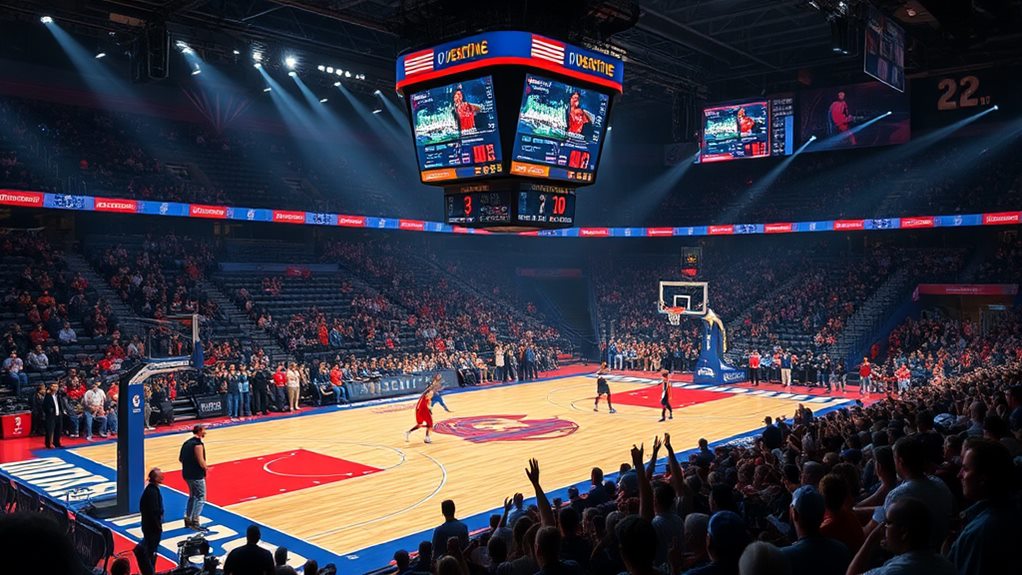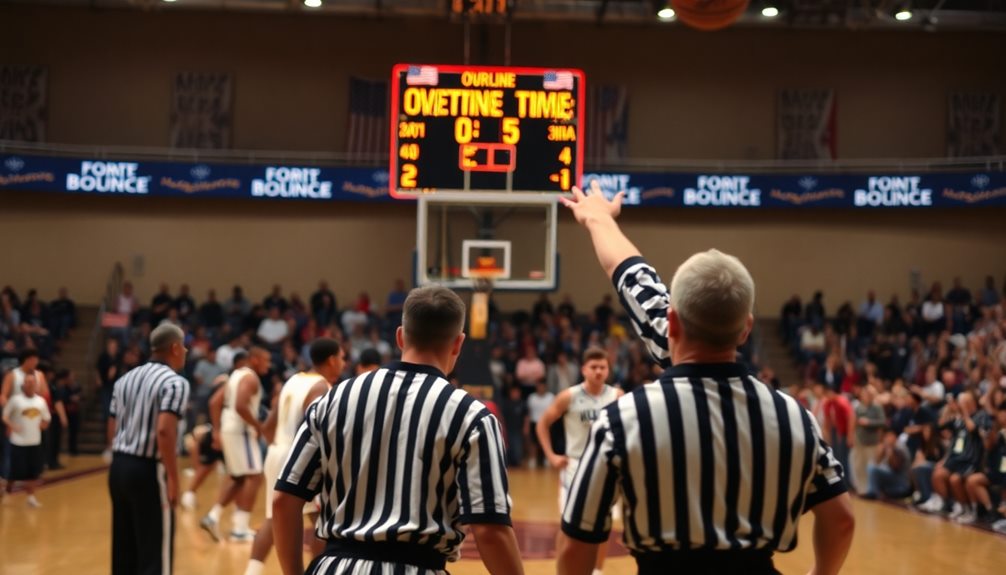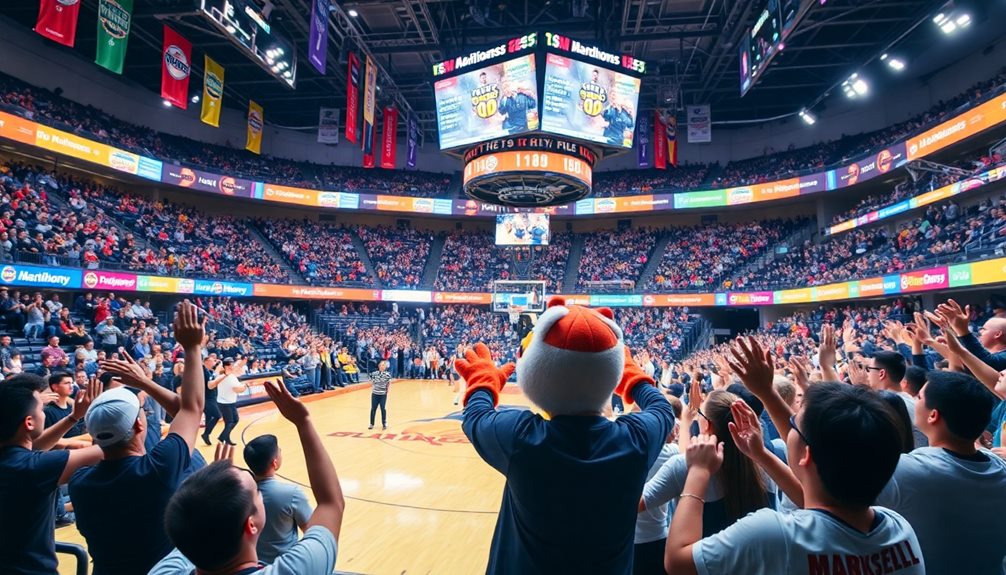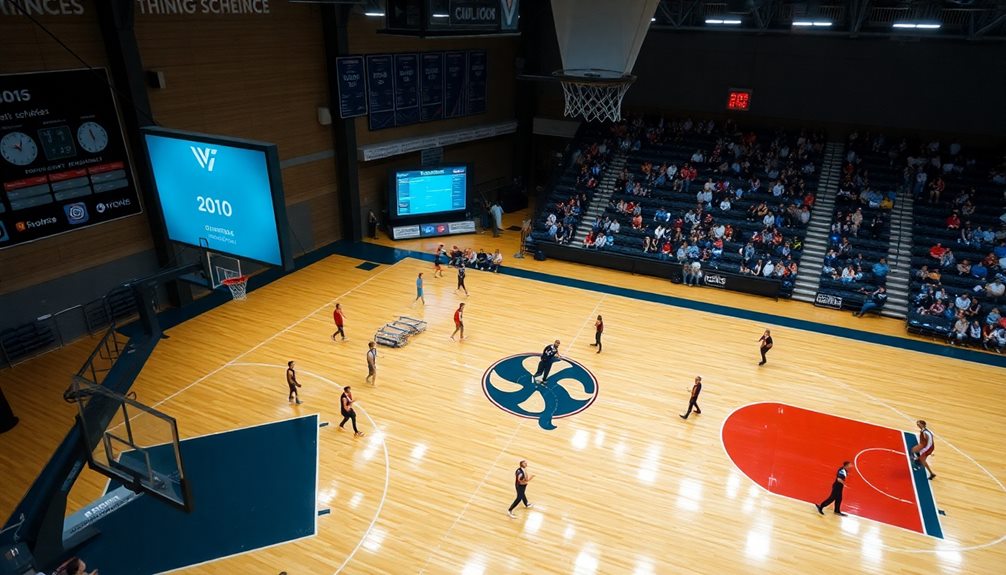
How Long Does a Basketball Game Last? Full Breakdown
December 6, 2024A basketball game typically lasts between 2 to 2.5 hours, depending on the league and other factors. For instance, NBA games have 48 minutes of actual playtime split into four 12-minute quarters. In contrast, NCAA games are 40 minutes long, while WNBA and FIBA games last 40 minutes, too—but with different structures. Keep in mind that stoppages for fouls, timeouts, and halftime breaks extend the total length. Overtime can also stretch games considerably, sometimes exceeding three hours. Curious about specific league rules and records? There's more to explore that adds even more context to game lengths!
Game Duration by League
When you watch a basketball game, the duration can vary considerably depending on the league. For NBA games, you'll find a total game time of 48 minutes, divided into four quarters of 12 minutes each. This structure contributes to the fast-paced nature of professional basketball, and the use of data analytics enhances player performance and strategies during these games.
On the other hand, WNBA games last 40 minutes, organized into two 20-minute halves, allowing for a slightly different flow.
In NCAA basketball, the men's games also total 40 minutes, split into two 20-minute halves. However, NCAA women's games follow a different format with four 10-minute quarters, creating a unique rhythm.
FIBA games mirror this international standard, totaling 40 minutes in four quarters of 10 minutes each.
Key Factors Affecting Length
The length of a basketball game isn't just determined by the clock; several key factors come into play that can profoundly affect the overall duration. In the NBA, games typically last about 2 to 2.5 hours, with only 48 minutes of actual playing time. Stoppages for foul calls, timeouts, and injuries can considerably extend this total duration.
The evolution of international tournaments has also influenced how games are structured, showcasing diverse playing styles and strategies that can impact pacing. Conversely, NCAA games have a total game length of 40 minutes divided into two 20-minute halves, but these often stretch to around 2 hours and 20 minutes due to halftimes and stoppages.
Timeouts are particularly impactful; in the NBA, teams can call a maximum of seven timeouts, adding over 15 minutes to the game. Mandatory timeouts contribute to these extended breaks as well.
Additionally, overtime periods, lasting 5 minutes each, can dramatically increase game length, especially in tightly contested matches. Factors like free throw situations and player injuries further contribute to stoppages, creating variations in game length across different levels of play.
Understanding these elements provides insight into the intricate nature of basketball history and how they affect your viewing experience, particularly as international tournaments continue to shape the sport's global landscape the impact of tournaments.
Overtime Rules Explained

Overtime comes into play when a basketball game ends in a tie after regulation time. Typically, an overtime period lasts 5 minutes. In the NBA, each team receives one additional timeout during this extra time. However, NCAA rules differ, as they allow for unlimited overtime periods until a winner is determined. This aspect of the game can be quite thrilling, reminiscent of the early days of basketball when teamwork and fair play were paramount, as emphasized by the YMCA's influence on character development.
The duration of overtime can considerably stretch the overall game length. While NBA games average around 2.5 hours, those with overtime can easily push toward 3 hours or more. The longest recorded NBA game featured six overtime periods, totaling 78 minutes of play, with a final score of 75-73.
It's essential to know that while the primary objective of overtime remains the same across leagues—to determine a winner—the rules may vary. In the NBA, you'll need to strategize using that extra timeout wisely, while in NCAA games, the absence of limits on overtime periods means the excitement can continue until one team prevails.
Understanding these overtime rules can enhance your appreciation of the game and its unpredictability.
Historical Game Length Records
When you look at historical game length records, you'll find some truly remarkable matches.
From the NBA's longest game in 1951 to the intense six-overtime battle in NCAA basketball, these games pushed the limits of endurance.
Significantly, Bill Russell's record-breaking 11 championships highlight the competitive spirit that drives players during these lengthy contests.
Plus, the WNBA's memorable overtime thriller showcases how different leagues have unique moments that keep fans on the edge of their seats.
Notable Longest NBA Games
Some of the longest games in NBA history have captivated fans and showcased the relentless spirit of competition. The record for the longest NBA game ever recorded took place on January 6, 1951, between the Rochester Royals and the Indianapolis Olympians. This epic showdown lasted a total time of 78 minutes, including six overtime periods. The final score of 75-73 in favor of the Olympians stands as a demonstration to the intensity of this competitive match.
Another notable long game occurred on November 9, 1989, when the Seattle SuperSonics faced off against the Denver Nuggets. This thrilling contest featured five overtime periods, marking it as the longest single overtime game in NBA history.
In modern plays, overtime periods typically extend the game duration by 5 minutes each, which can lead to lengthy and exhausting battles on the court.
The 2020 NBA playoffs also highlighted how quickly games can stretch into overtime, pushing teams to their limits. Such instances remind fans of the fierce competition that can define NBA history and the unforgettable moments that arise from these lengthy games.
Historic NCAA Game Lengths
While the NBA is known for its thrilling overtime games, the NCAA has its own history of extended matchups that have left fans on the edge of their seats.
The longest NCAA basketball game recorded took place on March 12, 2009, between Syracuse and Connecticut. This epic showdown lasted an astonishing six overtimes, pushing the total time to over three hours!
In a game that showcased incredible competition, both teams combined for 127 points, a proof of their relentless drive. Typically, NCAA men's games consist of two 20-minute halves, amounting to 40 minutes of regulation.
However, stoppages, fouls, and timeouts can greatly extend the overall duration. When a game ends in a tie, the 5-minute overtime periods can keep the excitement going.
Historic NCAA tournament games often see even longer durations due to the heightened stakes and competitive nature, with teams pushing the limits to secure their advancement.
These factors make NCAA games thrilling, with the potential for incredible marathon matchups that can redefine what you expect from college basketball.
WNBA Overtime Records
Although the WNBA typically features 40-minute games divided into four quarters, the potential for overtime can lead to thrilling, extended matchups that captivate fans. Overtime periods last 5 minutes each, and when the competition is fierce, these extensions can greatly increase the game time.
One of the most memorable instances occurred on June 30, 2002, when the Orlando Miracle faced off against the Cleveland Rockers in the longest WNBA game on record. This epic showdown lasted an astounding 2 hours and 57 minutes, including three overtime periods. The final score? A nail-biting 103-99, highlighting the intensity of the competition.
Here are some notable facts about WNBA overtime records:
- Longest Game: Orlando Miracle vs. Cleveland Rockers (2002).
- Total Minutes: 177 minutes including overtime.
- Overtime Periods: Three overtime sessions played.
- Final Score: 103-99, showcasing both teams' resilience.
These instances of overtime not only push the limits of endurance but also enhance viewer engagement, as fans remain riveted to the action until the very end.
Fan Engagement Strategies

To keep fans engaged during a basketball game, teams can implement a variety of strategies that enhance the overall experience. Engaging with fans through soccer resources like inspiration stories can also provide motivation and excitement.
During game stoppages, on-court performances and interactive activities are excellent ways to boost fan engagement, keeping the crowd entertained and increasing fan retention. You'll notice that merchandise sales often spike during these breaks, as fans have the chance to browse and purchase team gear.
Longer game durations also mean more opportunities for food and beverage sales. With extended breaks, you can grab a snack or drink without missing any action.
Utilizing digital platforms for fan interaction during stoppages, like live polls or giveaways, helps create a deeper connection with the team and enhances your experience.
Halftime is another prime opportunity for promotional events, such as contests or special performances, which not only attract larger crowds but also increase the entertainment value of the game.
These strategies not only keep you engaged but also create a lively atmosphere that makes attending games a memorable event. By focusing on these elements, teams can guarantee that you, the fan, leave satisfied and enthusiastic to return.
Game Breaks and Intervals
During a basketball game, breaks and intervals play an essential role in maintaining the flow of the game and allowing players to regroup. Understanding these breaks can enhance your viewing experience, especially since the duration of basketball games can vary considerably.
These breaks also provide opportunities for teams to adjust their strategies, influenced by innovations in offensive strategies that evolve over time.
Here's a breakdown of key breaks in basketball:
- Halftime: The National Basketball Association (NBA), NCAA, and FIBA competitions all feature a halftime interval of about 15 minutes, giving players a chance to strategize.
- Quarter Breaks: In the NBA, breaks between the first and third quarters usually last around 2-3 minutes, while NCAA games have shorter breaks between the two 20-minute halves.
- Timeouts: Each NBA team gets seven timeouts lasting 75 seconds each. These can extend the overall duration of the game considerably.
- Stoppages: Additional breaks for fouls, injuries, or reviews can add to the game's viewing time, resulting in an average duration of 2 to 2.5 hours for NBA games.
These intervals are vital, not just for players, but also for fans to absorb the action and excitement of basketball games.
Insights on Scheduling

Scheduling basketball games involves careful planning to maximize fan engagement and maintain a competitive atmosphere. Different leagues have varied game lengths that influence when and how games are scheduled. For instance, NBA games typically last around 2.5 hours, including timeouts and halftimes, while NCAA games run about 2 hours and 20 minutes due to longer halftimes and the potential for overtime.
Additionally, just like in soccer, where field dimensions and player conduct play a critical role in the game, basketball scheduling also requires an understanding of the dynamics and strategies involved in the sport, ensuring that each game is competitive and exciting for fans field dimensions and player conduct.
During the NBA playoffs, teams might play up to 105 games in a best-of-7 series, keeping game lengths consistent with the regular season. Conversely, FIBA games are shorter, lasting only 40 minutes, consisting of four 10-minute quarters, which allows for a faster pace and fewer stoppages.
When scheduling, leagues often prefer weekends and evenings for games, as these times maximize attendance and fan engagement. Additionally, the possibility of overtime adds an unpredictable element to scheduling, as tied games can extend beyond regulation.
Conclusion
In the end, understanding the length of a basketball game is like knowing the rhythm of a well-played song. Whether you're at an NBA showdown or a local high school match, the excitement builds with every tick of the clock. So, the next time you settle in to watch a game, you'll appreciate not just the action on the court, but the carefully crafted moments that make the experience unforgettable. Enjoy the game, and let the clock tick away!


